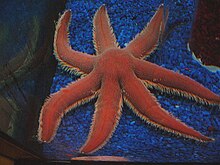Luidia ciliaris
| Seven armed starfish | |
|---|---|
 |
|
| Scientific classification | |
| Kingdom: | Animalia |
| Phylum: | Echinodermata |
| Class: | Asteroidea |
| Order: | Paxillosida |
| Family: | Luidiidae |
| Genus: | Luidia |
| Species: | L. ciliaris |
| Binomial name | |
|
Luidia ciliaris (Philippi, 1837) |
|
| Synonyms | |
|
|
The seven-armed sea star (Luidia ciliaris) is a species of sea star (starfish) in the family Luidiidae. It is found in the eastern Atlantic Ocean and the Mediterranean Sea.
Luidia ciliaris is an orangeish-brown colour and has seven long arms radiating from a small disk. It is a large but fragile sea star, growing to forty centimetres across, and easily losing its arms (which afterwards regenerate). The arms have parallel sides and taper only near the tip. They have a conspicuous fringe of white spines along the margins. The upper surface is clothed in paxillae, spines shaped like a pillar with a flat top bearing tiny spinules. There are also many-lobed, nipple-like papillae. There are no marginal plates on the upper side of the arms but those on the lower side bear pedicellariae with two valves. The tube feet are long and numerous. They do not have suction pads but have two sets of terminal bulbs. The gonads are arranged in two rows along the length of the arms. There is a mouth at the centre of the underside, an oesophagus and a cardiac stomach but no intestine, pyloric stomach or anus.
L. ciliaris occurs on the seabed in the eastern Atlantic Ocean from Norway and the Faroe Islands southwards to Cape Verde and the Azores and in the Mediterranean Sea. It is found in the neritic zone at depths down to four hundred metres, mainly on soft sediments into which it sometimes burrows, but sometimes on rock.
L. ciliaris is a predator and scavenger and feeds predominantly on other echinoderms. A study in the Irish Sea found that the brittle stars, Ophiothrix fragilis and Ophiura albida, and the sea urchin, Psammechinus miliaris, formed the chief items of prey. The brittle star Ophiocomina nigra was also consumed but in lesser quantities because it had more efficient escape strategies.
...
Wikipedia
